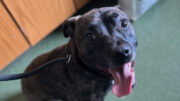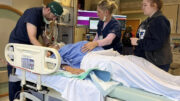HARRISBURG (AP) — Every region of Pennsylvania has seen an increase in the rate of positive coronavirus cases and failing to stop that could jeopardize the reopening of schools for the fall semester, the state’s top health official said Thursday.
In addition, Health Secretary Rachel Levine said the majority of counties have seen increases in the number of new cases.
“It’s critical to drive down the case counts now in terms of the rise of new cases in order to prepare for schools to reopen,” Levine said during a news conference Thursday. “If we don’t do that now, that would put that in jeopardy.”
In response to the rise in new cases, Gov. Tom Wolf’s administration last week imposed a new round of restrictions targeting bars, restaurants, nightclubs and indoor gatherings to slow the virus’ spread.
The order closed nightclubs and reduced bars and restaurants from 50% capacity to 25% capacity, while requiring that alcohol be served only with meals. That meant that some bars must close. Some restaurants did as well, saying they would only lose money at 25% capacity.
Wolf’s order also clamped down on indoor events and gatherings, reducing that limit from 250 people to 25. Places of worship are exempt.
The Democrat’s handling of the virus has drawn harsh criticism from Republican lawmakers. Restaurant and bar owners have questioned why the order was so broad, rather than simply shutting down establishments that were flouting mask requirements and social distancing guidelines.
President Donald Trump’s administration backed up the Wolf administration’s approach in some ways this week.
The White House sent Wolf’s administration a nine-page document Monday that cited rising cases in Allegheny County — a July virus hot spot — and recommended that bars be closed and indoor dining limited until there is a decrease in the positivity rate and new cases.
It also recommended keeping a mask mandate in place. The White House rates Pennsylvania in its yellow zone, the middle-of-the-road rating between its red and green zones for the spread of the virus.
In July, Pennsylvania’s 14-day rate of new cases per 100,000 residents has risen by more than 50%, from below 60 to 90.
The seven-day positivity rate — based on the Health Department’s daily public disclosures of the number of people who are newly confirmed to be positive and the number of people who tested negative — has gradually increased in July, from about 4.5% to 5.8%.
Deaths have declined from June to July, although hospitalizations are on the rise in July, according to state data.
The Department of Health reported more than 960 additional confirmed virus cases Thursday and 16 new deaths. The virus has infected more than 104,000 people in Pennsylvania since the beginning of the pandemic. More than 7,000 have died, most of them in nursing homes.
Levine said the data available to the Department of Health shows that the virus is spreading primarily to people in their 20s, 30s and 40s who are getting together in bars, restaurants and nightclubs. It is a trend, she said, being seen throughout the country and backed up by the White House’s observations.
Health officials in Philadelphia and Allegheny County have independently cited contact tracing information in line with that trend, as well.
Levine also warned of rising case counts in states along the East Coast.
“There are obviously significant outbreaks in Florida, in Arizona, in Texas, California now and other states, but we are seeing that come up the eastern seaboard,” Levine said. “There are increases in Georgia, the Carolinas, Virginia and Maryland, and so we’re not immune to the spread of this virus.”







































